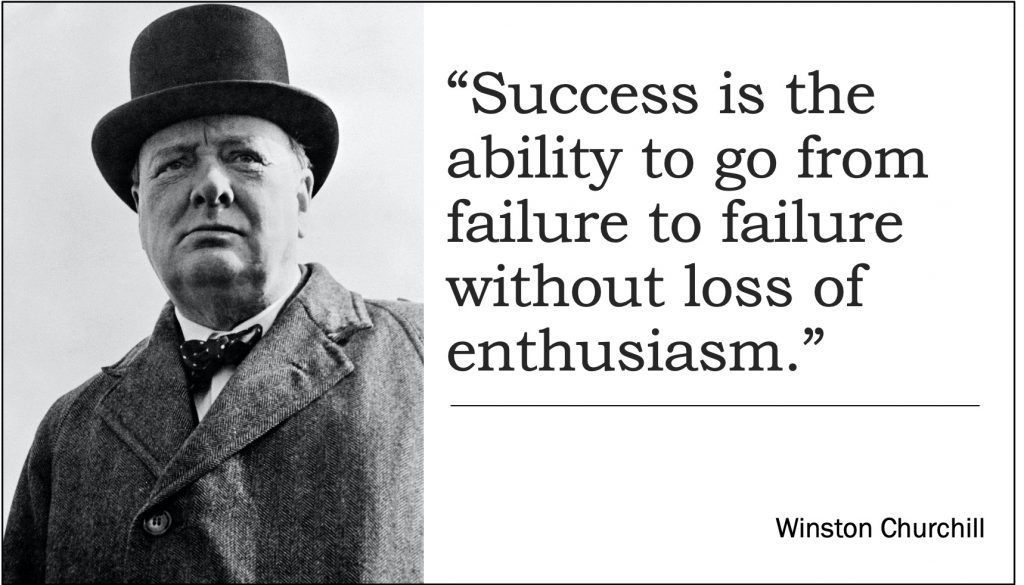Procrastination is the act of putting off until tomorrow what should be done today. 80 to 95 percent of university students regularly procrastinate, and almost half of graduate students report that they always or almost always put off writing their papers. Procrastination is a common illness that can have disastrous consequences. Those of us who practice it are well aware of its drawbacks. So why do we continue to procrastinate?
In this post, I explain how we often procrastinate for fear of failure and perfectionism and what to do about it.

A story of failure
Do you sometimes feel like a failure? Let’s see how that compares to Joanne’s story.
Like a lot of people, Jo wanted to be a writer. The idea of a children’s book was on her mind. So she started writing. Writing became her sanctuary, where vivid thoughts metamorphosed into words, painting vibrant worlds on the canvas of her pages. But a couple of months after she started writing her book, life threw her a curveball: Her beloved mother passed away. The loss was too painful; Jo fell into the murky waters of depression.
To avoid drowning, Jo decided to leave England for Portugal, where she could work as an English teacher and above all continue writing her book. In Portugal, Jo quickly fell in love and became pregnant. However, the shadows of her troubled marriage grew darker, and after the birth of her daughter, Jo made the painful realization that she needed to flee her husband’s jealousy and violence. Just thirteen months after their marriage, Jo moved to Scotland, with her precious little girl in tow.
In Scotland, Jo felt like she had hit rock bottom. She was a single mother, with a tiny baby she could barely feed, living from hand to mouth, with no work and no support. It didn’t last long before she fell back into depression. By all conventional measures, Jo had failed in all areas of her life.
With nothing to lose, Jo decided to put all her energy into the one project that really inspired her: The writing of her book. For weeks, she found refuge in a café, writing away while her baby slept nearby in a stroller.
When Jo finished her book, she sent it to publishers. One after the other, they rejected the manuscript. She persisted. The 13th publisher she sent her book to decided to give her a chance; the publisher’s 8-year-old daughter had read the first chapters and was hooked. This little girl was the first reader of a book that would revolutionize the world of millions of other children and adults: Harry Potter and the Philosopher’s Stone. A book that was about to make Jo or J.K. Rowling’s failures a multi-billion dollar success.
Failure is a necessary part of any enterprise. J.K. Rowling is not the only person who went through the lowest times before reaching the top. Edison made a thousand unsuccessful attempts to invent the light bulb. Before launching Microsoft, Bill Gates’ first start-up, Traf-O-Data, failed and had to be shut down.
Failures are inevitable and offer great learning opportunities if one takes the time to reflect on them. Yet for most people, the prospect of failure arouses fear and aversion.
Why are you afraid of failing?
The equation behind the fear of failure
People who are most inhibited by the fear of failure have a broad definition of the term “failure”. When they fail, they don’t just fail at a task; they feel they are failing as a person. More or less consciously, they assume that their performance is a direct reflection of their abilities and that these abilities determine their value as a person (see equation below).

What do you attribute the failure to?
Now, you can tell me that you don’t see what’s wrong with that equation. Isn’t it obvious that the best performers are also the most competent?
Ability is one of the factors that contribute to performance, but it’s not the only one. Effort also plays a role. You can be the fastest runner in the world, if you don’t move your legs fast enough, you won’t break any records. The conditions under which you perform are also decisive. If you have a stone in your shoe or if the wind is blowing against you, you will certainly be slower. Finally, the way your performance is evaluated is essential. If the referee is sleepy that day and does not press the stopwatch on time, your performance may seem poor even though you have made a good time. Hundreds of different factors contribute to a performance, some of which are related to ability, and many of which are not. Still, a poor performance can make us feel not only incapable but also unworthy as a person.
The idea that the value of a human being is determined by his or her abilities is dreadful. It would mean that people who are less capable are intrinsically less worthy. I bet that you would never subscribe to such eugenic views. Yet, when it comes to ourselves, we often unconsciously apply this kind of reasoning.
Procrastination is a strategy to avoid failure
Many insecure people use procrastination as a strategy to break the equation between performance and ability. If they wait until the last minute to accomplish the dreaded task, they lack the time to deliver a high-quality performance. They can then attribute their failure to a lack of effort rather than to a lack of capacity and thus protect their own worth.

Procrastination and perfectionism
Perfectionists often use procrastination to avoid questioning their abilities.
There are two different kinds of perfectionism: adaptive and maladaptive. Adaptive perfectionists have high standards, which they manage to attain. Their ambitions are realistic, and their performances live up to them. Maladaptive perfectionists also have high standards but these standards are often unrealistic, and leave them disappointed. Maladaptive perfectionnists are prone to self-criticism, low self-esteem, and are vulnerable to depression.

Two types of perfectionists and two mindsets
Dr. Carol Dweck, a researcher at Standford University, found that maladaptive perfectionists display a fixed mindset. People with fixed mindsets believe that intelligence and talent are fixed traits that cannot be changed. They also believe that talent alone leads to success, and that effort is not required. When faced with challenges, people with a fixed mindset withdraw and lose interest. They avoid tasks that might prove their inadequacy. Procrastination protects people with fixed mindsets from taking risks that might result in failure and demonstrate their inability and unworthiness.
The opposite of the fixed mindset is a growth mindset, the belief that one can improve one’s abilities with time and effort. People with a growth mindset understand that effort makes them better and stronger. As a result, they work hard, which leads to higher achievement. But how do you get from a fixed mindset to a growth mindset?
Overcoming fear of failure
Cultivating a growth mindset is a method to undo the self-worth equation. Not only does performance then cease to reflect one’s value as a person, but it is no longer a central concern. In a growth mindset, the only thing that matters is to learn, tackle exciting challenges, and improve. The path to move from a fixed to a growth mindset begins with changing one’s thoughts. Cognitive restructuring has proven to be effective in achieving this goal.

Using cognitive restructuring to decrease fear of failure
Cognitive restructuring (Gesundheit!) is a psychological technique that aims to identify thoughts and correct those that are unhelpful. These kinds of thoughts are called cognitive distortions. Cognitive distortions are habitual ways of thinking that are inaccurate and negatively biased. They work like dirty glasses that cast a negative light on our perception of the world.
Do these thoughts resonate with you?
Here are some examples of cognitive distortions:
- All-or-nothing thinking: There is only success or failure, nothing in between (e.g., “I didn’t get straight As this semester; that means I’m a failure”). This kind of thinking is typical of perfectionists.
- Overgeneralization: Drawing broad conclusions from a single event (“I got dumped by my boyfriend; something with me is wrong, I can’t have a lasting relationship”).
- Should statements: The thought that one should do something or be in a certain way (“I should have finished my thesis long ago”).
- Mind reading: Assuming one knows what others think (e.g., “my supervisor hated my paper, I can feel it!”).
- Fortune telling (also called Jumping to conclusions): Assuming one knows what will happen in the future (e.g., “I will never get a good position”).
- Catastrophizing: Imagining that the worst has happened or will happen (e.g., “My husband is late; he probably had a car accident”).
- Personalization: Taking things personally even when they are not related or caused by you (e.g., “We came late to the party and ruined the mood. If I only I had told my boyfriend to leave earlier!”).
- Mental filter: Focusing on the negative details and leaving out the positive ones (for example, paying attention only to criticism and not to compliments).
- Disqualifying the positive: Explaining positive events as irrelevant (e.g., “he complimented me to cheer me up, he didn’t really mean it”).
- Labeling: Reducing a person (oneself or someone else) as one negative characteristic (e.g., “I’m a loser”, “he’s a jerk”).
How to correct unhelpful thoughts?
After identifying unhelpful thoughts, the cognitive restructuring method involves questioning them. Are you 100% sure that this thought is true? Can you find one reason why this may not be true? What could it be? How would someone else see your situation? Once you’ve answered these questions, talk back to your thoughts in a rational way. For example: “My supervisor never said that she hated my dissertation. Some of the comments she made were even positive. I’ve put a lot of effort into this dissertation and I can be proud of it”. The cognitive restructuring method is powerful. Not only does it help to change one’s unhelpful thoughts and the emotions they trigger, but it also helps to see things in a broader and more accurate way.
Time to feel good about your failures
If you are struggling with these kinds of thoughts and fear of failure and if you want to do something about it, I recommend that you read David Burns’ book “Feeling Good”. This book is a reference in the field of cognitive restructuring; it is easy to read and full of simple exercises to work with your own thoughts. It’s helped thousands of people overcome their fears and insecurities. It’s helped me so much! Maybe, can it also help you.
In Sum
Procrastination plagues many scientists and paints a shadow over the brightest minds. The real root of procrastination often lies in the fear of failure, and the quest for unattainable perfection. To tackle this issue head-on, we’ve taken a page from the life of J.K. Rowling, a true exemplar of resilience. Her journey from adversity to unimaginable success highlights the power of perseverance in the face of failure.
But it’s not just about J.K. Rowling’s story; it’s about your story too. Fear of failure can be debilitating and the equation of performance equating to self-worth is a trap many fall into. Thus, it’s time to break free from this cycle. The solution lies in cultivating a growth mindset, where the focus shifts from perfection to progress, and learning becomes the ultimate goal.
So, here’s your call to action: start by recognizing those unhelpful thoughts that hold you back. Challenge them with the cognitive restructuring method we’ve discussed, and witness how it transforms your perspective. Don’t let procrastination continue to steal your potential. And if you want to dig deeper into the topic of procrastination you’ll find many more resources on our blog such as this post on “Why Do We Procrastinate and How to Stop” or this one on “12 Ways to Motivate Yourself to Start Writing“.
I wish you the best of luck!
Cover photo by Ian Kim on Unsplash; Heckecl and Jeckel photo by This Photo by Unknown Author is licensed under CC BY-SA; Churchill photo by 272447 from Pixabay; “Perfect” photo by Jonathan Hoxmark on Unsplash; “Brain” photo by Sarah Pflug from Burst


This is quite motivating.
Thanks, Noreen!
All the best from sunny Graz,
Gaya
Pingback: How to stop thinking about work when you're not working - A Brilliant Mind
Pingback: Free-writing: The method for sorting out your thoughts : A Brilliant Mind
Pingback: Goal setting: A masterclass with Dr. Ana Pineda : A Brilliant Mind